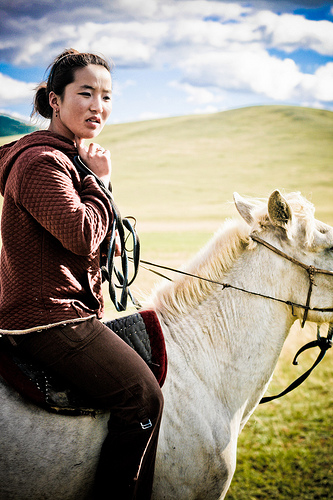
Half of the story behind the Great Walls of China isn’t in China. Even when you have a very good tour guide, read lots of books and watch lots of films, you still get half of the story. To fully understand and visualize the origin of this wonder of the world, you need to go to the other side and meet the descendants of the people who once terrorized not only China but also half of the world.
I visited Mongolia in the 21st the century, the era under rapid urbanization and unprecedented development and progress in technology, yet I felt like walking in the past: people wearing traditional costumes, herding their animals on horseback, living in tents and moving about with their animals.
Most herders lived in round, portable tents, called ger (Mongolian) or yurt (Russian), insulated from animal skin. Some nomads moved back to nearby towns to live in wooden shelter in the winter. Because of the animals, they often lived near the water. During our self-tour driving around Mongolia, we often camped near a ger to be near to the water as It was difficult if not impossible to locate water with our eyes in this huge open landscape with nothing but horizon, mountain and grass as our landmarks. Rivers were often narrow, hidden behind higher ground completely covered by grass. They were not the types of high-volume or large body of rivers that flew through cities and villages. Mongolian rivers looked more like water-filled cracks on the ground.
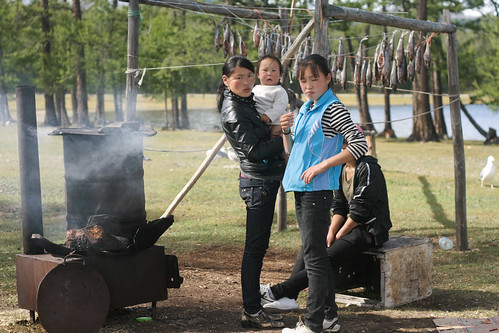
A nomadic family in the North at Lake Khovsgol. In the summer, they lived near the lake, fished, smoked them for eating and selling to the tourists to supplement their income. In the winter, they moved back to the Khatgal, the main town.
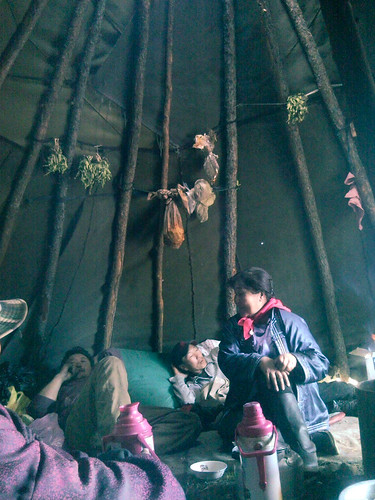
These are the Tsaatans, reindeer people. Unlike other herders, they lived in tepee not ger. Their natural habitat was further up North in Tsagaan Nuur, deep in the taiga, thick Siberian forest near the border with Russia. This particular family moved with their reindeers Lake Khovsgol during the summer to entertain tourists. By the time we met them, they had already took all their reindeers back to Tsagaan Nuur. The lady in the photo was a respectable sharman. Read this and this if you’re interest in our group’s drama for finding these Tsaatan people and learned how to understand different people’s expectation and travel in a diverse group of complete strangers.

A nomadic family in the Gobi desert
The life of nomads centered around their livestocks, mainly the five species: horses, cows or yaks, goats, sheep and camels. They moved at least twice in a year to more suitable environments for their animals. In the summer, they harvested the fields, gathered grass and made hay bales to prepare for winter. Each family had its own lot. There was no marking nor sign claiming ownership but everyone knew the owner of the land. During my horse-riding trip, we didn’t camp wherever we wanted. Instead we had to set up camp at certain areas where the guide had the owner’s permission to let our horses graze the land.
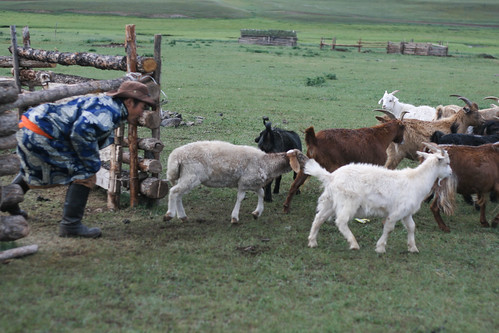
A sheep and goat herd in Central Mongolia
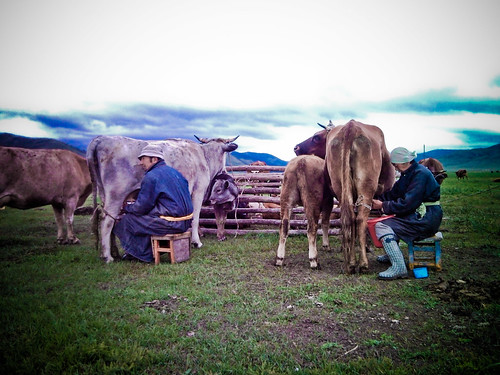
Husband and wife milking the cow
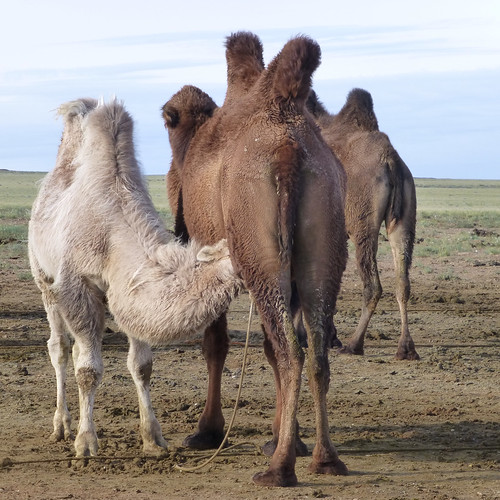
Camels in the Gobi desert
Every Mongolian could ride horse, the most important animal for herders. If he wasn’t born in the capital, then he probably master this art, a skills he acquired since the age of five. By the time he turned 12, he could tend his family’s big herd. He probably knew how to hunt wild animals. Once our car was stopped by a small boy, about 10 year-old. He carried in his hand a mammoth and asked if we wanted to buy it.

A boy seen herding his yaks
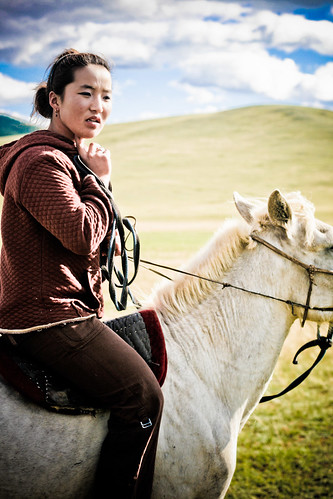
A young herder we asked for direction
Mongolia’s three big sports are wrestling, horse-riding and archery, obviously the necessary skills for warriors in ancient time. To understand how popular and important these sports are to Mongolia, one doesn’t have too look farther than the Olympic results. Despite being a poor and small country of only two millions, Mongolians have won a lot of Olympic medals for wrestling and Judo, a wrestling-style martial art.

My guide wrestled the baby yak
Despite being an Asian culture and having thousands of years interacting and mingling with the Chinese, known for their rich, extravagant, sophisticated cuisines, Mongolian cuisine was plain and basic, probably due to a lifestyle which ones roamed from one place to another, families lived isolated from one another, herders separated from their own families while herding their animals during the day. This kind of lifestyle didn’t encourage the slow and sharing food culture of other Asian countries. Food, of course, was important to Mongolians, but they ate to live and not lived to eat like typical Asians. They ate what were available to them. For the entire time roaming the steppe and the desert, I ate most dairy products (dried milk, cream, fermented horse milk…) and meat (mostly mutton) in addition to imported packaged and canned foodstuff from convenient stores. I ate so much mutton that I could smell mutton fat and unseasoned meat at every restaurant and eatery in Mongolia.
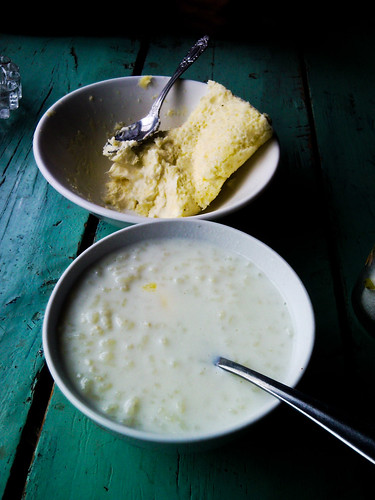
Sweet milk rice with creamy butter
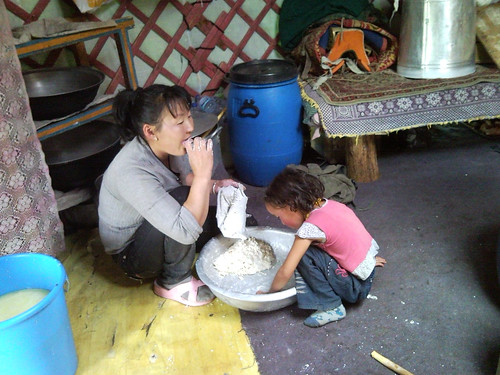
This woman was making sweet. She said that work was never ending for a nomadic wife.

Another wife preparing the milk
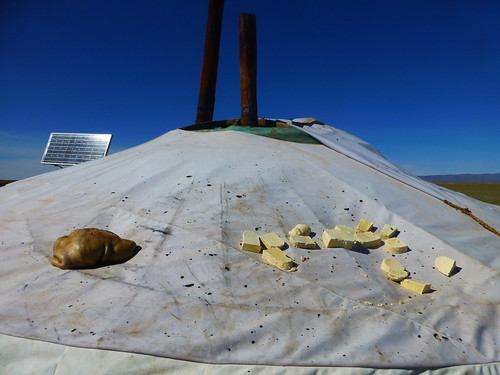
Dried milk
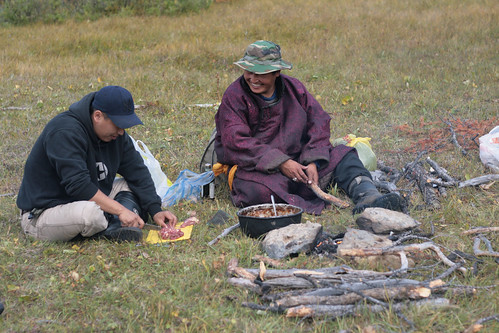
This was how we cooked during our horse-trekking tour, stirred-fried mutton and fried dough: throwing meat and dough together in a big pot. But home-cooking Mongolian cuisine didn’t really stray far from this.
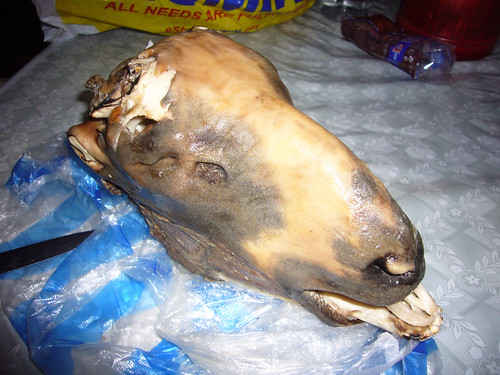
Sheep head we bought in the Gobi desert
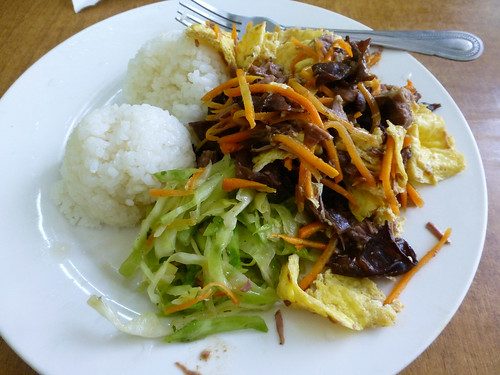
This looked similar to other Asian dish, but the taste was plain and I could smell mutton fat from miles away.
Going to the toilet was probably one of the most convenient thing in Mongolia, one big giant toilet. Of everything I could and should learn in a new country, I picked up a new trick on how to do number 1 right in the presence of others, not that Mongolians cared how you did it anyway. Mongolians gave another definition to the term “toilet.” Once while sitting in the car, I heard my tour guide said: “there was a toilet,” and the driver stopped. I looked outside trying to find one but couldn’t see any. The guide then pointed to a bump on the road side, walked behind it, pulled down her pants and sat down. “This is the toilet because people driving on the road can’t see you,” another group member explained to me. “Oh that what it meant.” Some shit-pits were human-friendly, but some were disgusting. “They don’t care about it, because when it’s full, they will just cover it and dig a new hole. They move to a new place anyway.”
If this is how half of Mongolian population lived in the 21st century, what could possibly be their lifestyle hundreds, thousands years ago when life was a lot harsher and people were governed not by international laws but by jungle code. For the Mongol and Turkic Central Asian nomadic tribes who were less interested in developing towns and a settled lifestyle than roaming around, looking for suitable places, where else would have more food, crops, animals and wealths than China? When Chinese rulers were strong, the tribes traded with the Chinese or at most looted Chinese villages and cities. But when China was on the decline, these tribes crossed the border, advanced further to the South, defeated Chinese soldiers, declared themselves to be superior rulers and forced Chinese emperors to call them “uncle”, gave them more land, jewelries and women.
Thus rulers starting from the birth of China, 220 BC during Qin Shi Huang reign, to the Ming, the last Han Chinese dynasty, built different stretches of the walls to stop these Northern barbarians. But the walls couldn’t stop the warlike Mongols who raced to climb the walls in order to fulfill their rite of passage to manhood. “You are not a real man if you haven’t climbed over the Great Walls,” said Chinggis Khaan.
12 thoughts on “Mongol Nomads and the Great Walls of China”
cleopatra slotsPosted on 6:38 am - Feb 4, 2022
luckyland slots https://411slotmachine.com/
quick hits free slotsPosted on 5:00 am - Feb 4, 2022
2022 mlb draft bonus slots https://download-slot-machines.com/
free slots just for funPosted on 11:49 pm - Feb 3, 2022
free caesars slots online https://beat-slot-machines.com/
dnd level 6 spell slotsPosted on 7:59 pm - Feb 3, 2022
heart of vegas free slots https://slot-machine-sale.com/
free wizard of oz slotsPosted on 6:20 pm - Feb 3, 2022
caesar casino slots game https://slotmachinesforum.net/
free vegas penny slotsPosted on 7:37 am - Jan 29, 2022
wizard of oz slots zynga https://slotmachinesworld.com/
8pm news slotsPosted on 2:04 am - Jan 29, 2022
harrington slots buffet https://candylandslotmachine.com/
gay dating east tennesseePosted on 9:11 pm - Jan 15, 2022
dating gay costa rican men https://speedgaydate.com/
gay incet chatPosted on 8:58 pm - Jan 14, 2022
free live gay webcam chat rooms https://gay-buddies.com/
local gay chatPosted on 4:40 pm - Jan 14, 2022
in gay chat what is an otter? https://gaytgpost.com/
gay chat aveneuPosted on 11:11 am - Jan 14, 2022
free chat on gay webcam https://bjsgaychatroom.info/
3mosquitoPosted on 11:35 pm - Jan 12, 2022
3unprovoked